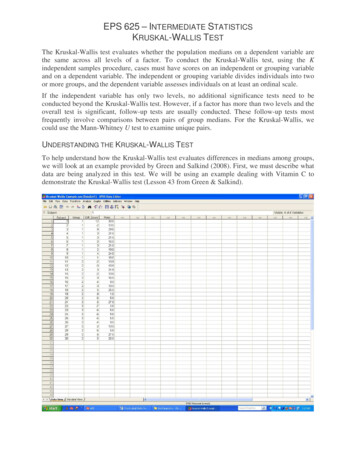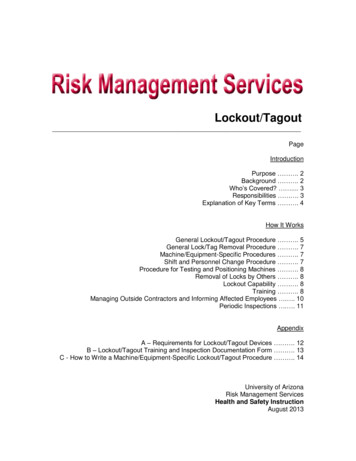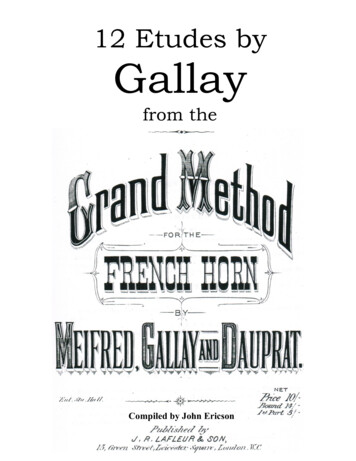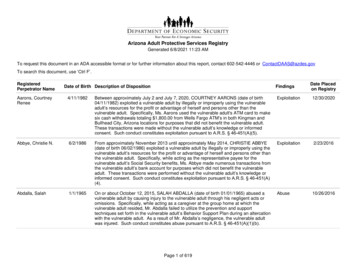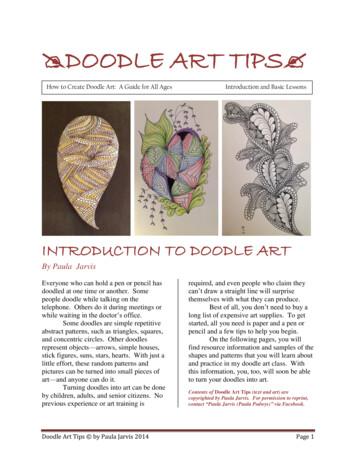
Transcription
DOODLE ART TIPS How to Create Doodle Art: A Guide for All AgesIntroduction and Basic LessonsINTRODUCTION TO DOODLE ARTBy Paula JarvisEveryone who can hold a pen or pencil hasdoodled at one time or another. Somepeople doodle while talking on thetelephone. Others do it during meetings orwhile waiting in the doctor’s office.Some doodles are simple repetitiveabstract patterns, such as triangles, squares,and concentric circles. Other doodlesrepresent objects—arrows, simple houses,stick figures, suns, stars, hearts. With just alittle effort, these random patterns andpictures can be turned into small pieces ofart—and anyone can do it.Turning doodles into art can be doneby children, adults, and senior citizens. Noprevious experience or art training isDoodle Art Tips by Paula Jarvis 2014required, and even people who claim theycan’t draw a straight line will surprisethemselves with what they can produce.Best of all, you don’t need to buy along list of expensive art supplies. To getstarted, all you need is paper and a pen orpencil and a few tips to help you begin.On the following pages, you willfind resource information and samples of theshapes and patterns that you will learn aboutand practice in my doodle art class. Withthis information, you, too, will soon be ableto turn your doodles into art.Contents of Doodle Art Tips (text and art) arecopyrighted by Paula Jarvis. For permission to reprint,contact “Paula Jarvis (Paula Podwys)” via Facebook.Page 1
WHAT YOU WILL NEEDYou can begin creating doodle art with anykind of unlined paper in any size. However,it’s a good idea to use a smaller sheetbecause it will take less time and energy tofill it with repeated patterns (and it will takeless ink if you are using a pen).You can buy sketch books anddrawing pads in 4” by 6” and 5” by 8” sizesor you can cut down 9” by 12” sheets ofdrawing paper into the size you prefer. Ifyou like to work in very small formats, youcan buy packs of artist trading cards (ATCs)in most art supply stores. ATCs are 2.5” by3.5” and come a variety of materials,including smooth and vellum (slightlytextured) Bristol paper.After working in many sizes and onmany different kinds of paper (includingbright white and off white), I now like to use4” by 6” unlined index cards. When mydrawings are finished, I store them ininexpensive 4” by 6” photo albums (24photos per album) that are available onlineand in many drugstores.I use standard No. 2 pencils (whichare the same as HB drawing pencils) forDoodle Art Tips by Paula Jarvis 2014sketching ideas, practicing patterns, andsometimes for shading my final drawing.However, I use a pen for my actual doodleart because I like the boldness of black inkagainst white paper. Many doodle artistslike to use Sakura Micron 01 pens (alsoknown as Pigma pens). These havewaterproof ink and a very fine (0.25mm) tip.(Sakura Micron pens come six nib sizes:Size 005 0.20mm, 01 0.25mm, 02 0.30mm, 03 0.35mm, 05 0.45mm, and08 0.50mm. Note that the sizes are listedon the barrel and on the top of the cap.)I find that the Sakura Micron penbarrel, which is straight and quite narrow, isuncomfortable to use for long drawingsessions. Instead, I prefer to use aretractable Pentel EnerGel or EnerGel X0.5mm (needle top) liquid gel ink pen. Theink is waterproof, and the barrel is largerand more comfortable than the Sakura pen.At 0.5mm, the Pentel nib is the same size asthe largest Sakura Micron pen (size 08) butworks well for most of my drawings. WhenI need to make a finer line, I use a SakuraMicron size 01 or 005 pen.—PJPage 2
ADDITIONAL RESOURCESOPTIONAL ART SUPPLIES Archival paper if you want your art to lastfor generations to come Graph paper if you enjoy working withgeometric forms Toned paper (tan, grey, other colors) Black paper Official Zentangle tiles (available onlineor through official Zentangle teachers) Ruler Kneaded eraser (usually gray or blue) Vinyl eraser (usually white) Blender stump or tortillon Hand-held two-hole pencil sharpener Compass and protractor (if you plan tocreate mandalas and other symmetricaldesigns) Templates and stencils (circles, ovals,triangles, rectangles, hearts, stars, etc.) Colored pencils (Crayola colored pencilsare inexpensive and work fine but are notlightfast. Prismacolor pencils are moreexpensive but are lightfast and readilyavailable in open stock at art supply stores.) Colored ink pens, gel pens, brush pens,markers, watercolor pencils, etc.Doodle Art Tips by Paula Jarvis 2014RECOMMENDED BOOKS The Art of Zentangle, pub. by Walter Foster The Beauty of Zentangle by SuzanneMcNeill and Cindy Shepard Joy of Zentangle by contributing artistsSuzanne McNeill, Sandy SteenBartholomew, and Marie Browning* Made in the Shade by Cris Letourneau One Zentangle a Day by Beckah Krahula Totally Tangled by Sandy SteenBartholomew* Zen Doodle: Tons of Tangles, edited byTonia Jenny and Amy Jones Zen Mandalas by Suzanne McNeill Published by Dover: 1000 OrnamentalDesigns for Artists and Craftspeople, editedby Claude Humbert, A Treasury of Designfor Artists and Craftsmen by GregoryMirow, Early American EmbroideryDesigns: An 1815 Manuscript Album withover 190 Patterns by Elizabeth M.Townshend, Mehndi Designs: TraditionalHenna Body Art by Marty Noble. OtherDover books featuring ethnic and folk artmotifs and collections of historic patterns.*If you want to start with just one book, either ofthese would be a good choice for beginners.WEBSITES Search Internet for doodle art, Zendoodles,and Zentangles, as well as embroidery,mehndi (henna), paisley, and pysanky(Ukrainian egg decorating) patterns. http://creativedoodlingwithjudy.blogspot.com/ http://www.zentangle.com TanglePatterns.comFACEBOOK DOODLING GROUPS DoodleArt Friends of Zentangle Ornation CreationPage 3
LESSON 1: SIMPLE SHAPESBasic doodle art begins with a simple shapeor outline that is divided into sections, witheach section then being filled in with arepeated pattern. The initial shape (whichDoodle Art Tips by Paula Jarvis 2014can be added to and embellished in manyways) can be done free-hand or by using atemplate or stencil. Here are examples ofsome simple shapes.Page 4
LESSON 2: SIMPLE SECTIONSOnce you have drawn your shape (outline),divide it into sections. As you work on yourdrawing, you may decide to divide some ofyour larger sections into smaller sections.Doodle Art Tips by Paula Jarvis 2014You may also decide to alter your shape byadding sections outside of the outline tocreate a different overall shape. Feel free tochange both your shape and your sections.Page 5
LESSON 3: PATTERNS and VARIATIONSPatterns (or motifs) used in basic doodle artfall into the following categories: Lines(straight and curved, thin and wide, parallel,radiating, undulating); dots, circles, ovals,squares, and diamonds; “mountains” (peaks,zigzags, triangles); “hills” (“mountains”with curved tops); braids and weaves;“shingles” (or “scales”); “over-and-under”lines; grids (multiple straight or curvedintersecting lines that form square,rectangular, or diamond patterns); flowersand foliage; and filler patterns (“gravel,”“scribbles,” and “swirls”).A note about “mistakes”: Mistakes made inink can’t be erased, but they can be turnedinto “happy accidents” by changing yourdesign to include or obscure the flaw. Useyour creativity. The result can be evenbetter than what you’d originally planned.Shown above are examples of the many ways in which simple lines can be used. Sections can befilled in with parallel lines or with lines that radiate from a single point (radiating lines or “rays)beginning at the corner of a section, at the side, or in the middle. Sections can also be filled withundulating lines that seem to ripple. See below to learn how to create an “undulating” line.Doodle Art Tips by Paula Jarvis 2014Page 6
PATTERNS and VARIATIONS continuedShown above are examples of “mountains” (triangles, zigzags, peaks) and “hills” (“mountain”patterns with rounded tops). Almost any “mountain” (triangular) design can become a “hill”design. Shown below are three “braid and weave” designs that can be done with straight lines orwith curved lines. See next page for examples of braid-and-weave patterns in use.Doodle Art Tips by Paula Jarvis 2014Page 7
PATTERNS and VARIATIONS continuedAbove, braid-and-weave patterns used in doodle art. Below: Grid and over-and-under patterns.Doodle Art Tips by Paula Jarvis 2014Page 8
PATTERNS and VARIATIONS continuedDoodle Art Tips by Paula Jarvis 2014Page 9
LESSON 4: PUTTING IT ALL TOGETHERAbove center: This star is filled with what I call “granulations” (inspired by ancient jewelrymade with tiny dots of gold or silver that jewelers call granulations). First I filled the star withnarrow lines and then I drew small circles (sometimes ovals) between the lines. The result ismuch different from the results you get when you use the “gravel” pattern. Above right: Thisdoodled hand is from my 30-day “My Daily Hand” project. I outlined my left hand each day for30 days and then doodled and decorated each one with different designs. I left some hands blackand white and colored others. Below left: Notice how curving lines within a round or ovalshape create a “cushiony” effect. Below right: This design is filled with undulating lines thatlook a little like 1970s Op Art. (Can you see my mistake and how I fixed it?)The works of Dutch artist M. C. Escher and examplesof Op Art can provide inspiration for your doodle art.Doodle Art Tips by Paula Jarvis 2014Page 10
PUTTING IT ALL TOGETHER continuedThe doodles on this page are some of my earliest ones. In the beginning, I used only black andwhite, but I later discovered that adding a touch of color can really enhance some pieces ofdoodle art. If you aren't sure that color would improve one of your drawings, make one or twophotocopies and experiment on the copies to see if color helps or hinders your design.Bottom photos: I used various sizes of oval and circle templates for these designs.Doodle Art Tips by Paula Jarvis 2014Page 11
A DOODLE ART SCRAPBOOKDoodle Art Tips by Paula Jarvis 2014Page 12
Doodle Art Tips by Paula Jarvis 2014Page 13
Doodle Art Tips by Paula Jarvis 2014Page 14
Doodle Art Tips by Paula Jarvis 2014Page 15
A template can make a goodstarting point for a doodle. Inaddition to geometric forms,templates come in a wide varietyof shapes, from hearts and stars topalm trees and penguins.Doodle Art Tips by Paula Jarvis 2014Page 16
To challenge your creativity, pick atheme. Try doodling a differentheart every day during February, ordoodle an outline of your hand eachday during your birthday month.Doodle Art Tips by Paula Jarvis 2014Page 17
Doodle Art Tips by Paula Jarvis 2014Page 18
A touch of color can make a big difference inyour doodle art. If you are hesitant to usecolor, consider scanning your drawing ormaking some photocopies. Then try outvarious colors schemes on the copies beforeyou add color to your original drawing.Doodle Art Tips by Paula Jarvis 2014Page 19
Doodle Art Tips by Paula Jarvis 2014Page 20
Doodle Art Tips by Paula Jarvis 2014Page 21
WHAT’S IN A NAME? Doodling has been around since the firstcave man used a stick to decorate the rockwalls of his home. For modern-daydoodlers, rocks have been replaced bymemo pads and sticky notes, but the impulseto doodle remains the same.When a form of structured doodlingcalled the Zentangle Method was firstpublicized in 2005, its originators promotedtheir system as a way of teaching adults andchildren to make art by using simple strokesto create repeated patterns. In addition, theyreported that it helps some practitionersachieve a Zen-like meditative state, hencethe trademarked name Zentangle .Although many doodlers havechosen to follow the Zentangle MethodDoodle Art Tips by Paula Jarvis 2014exclusively, others prefer a more flexibleapproach. (See the Zentangle founders’patent application [still pending] for a list ofthe Zentangle Method’s shtml.)To avoid trademark-infringementissues and to reflect their own less restrictivestyle, these doodlers avoid the Zentangle name. Instead, they describe their drawingsas Zendoodles, line weavings, patterndesigns, or simply doodles.However, no matter what you callthis engrossing hobby, doodle art is easy,fun, and rewarding. And anyone, even you,can do it!—PJPage 22
Totally Tangled by Sandy Steen Bartholomew* Zen Doodle: Tons of Tangles, edited by Tonia Jenny and Amy Jones Zen Mandalas by Suzanne McNeill Published by Dover: 1000 Ornamental Designs for Artists and Craftspeople, edited by Claude Humbert, A Treasury of Design for Artists and Craftsmen by Gregory Mirow, Early American Embroidery




